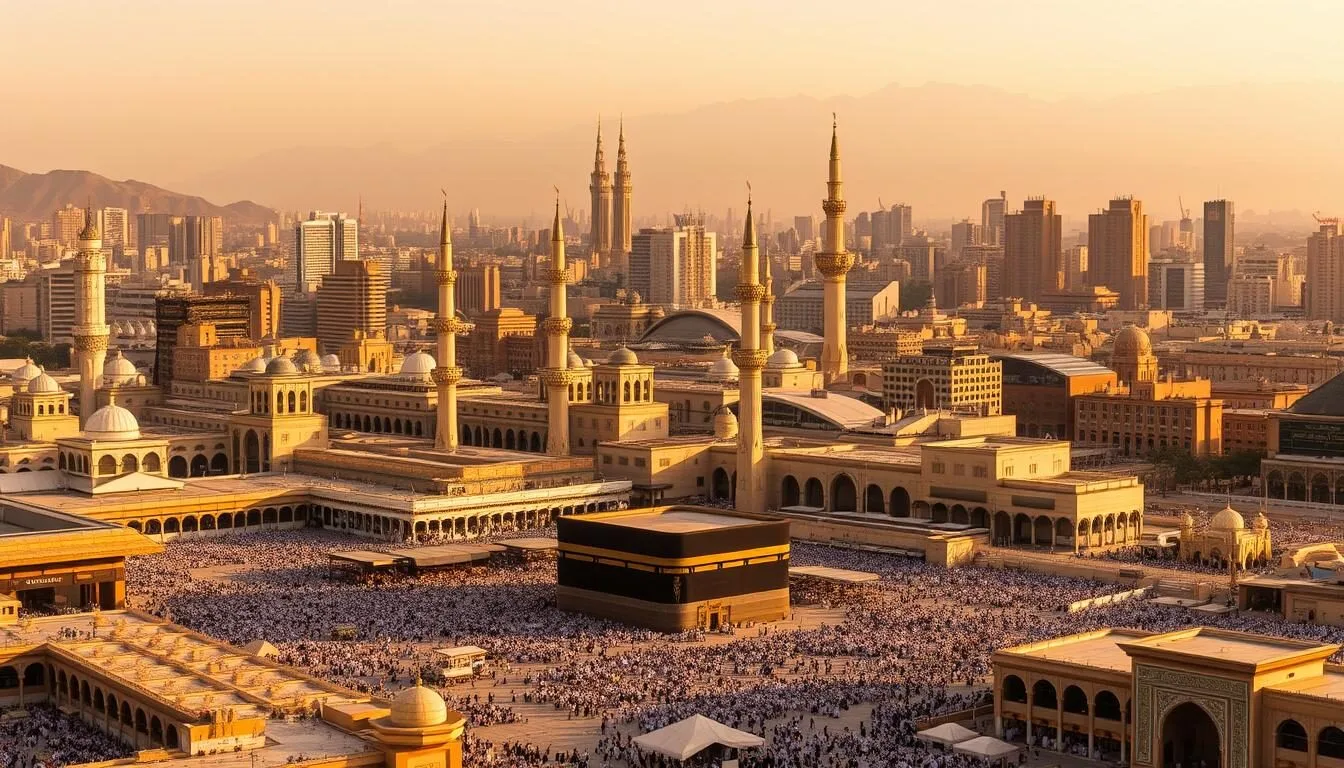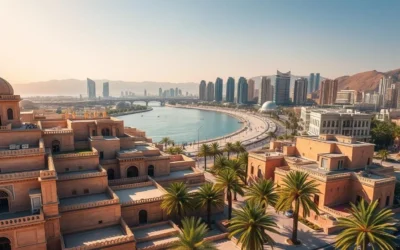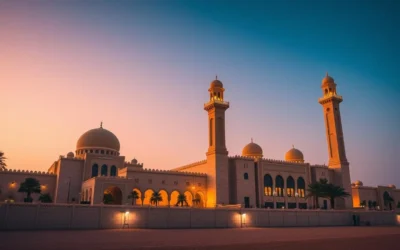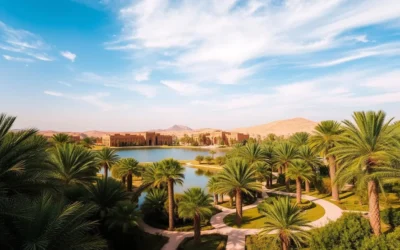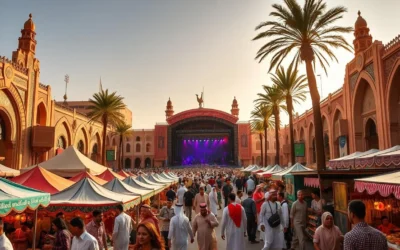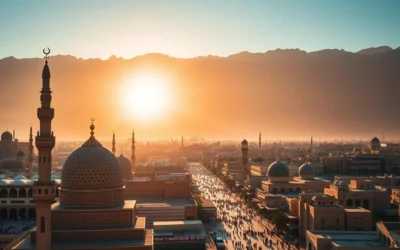Every year, millions of pilgrims travel to the holy city of Mecca in Saudi Arabia, making it one of the most visited places on earth. As the birthplace of Prophet Muhammad and home to the Sacred Mosque, Mecca holds immense significance for Muslims worldwide.
As you plan your journey to this sacred city, you’ll discover a unique blend of historical landmarks, cultural experiences, and spiritual attractions. From the revered Kaaba to the surrounding mountains, Mecca offers an experience like no other. Whether you’re performing Umrah or simply exploring the attractions, Mecca is a destination that will leave a lasting impression.
In this guide, we’ll take you through the top things to do and see in Mecca, helping you make the most of your visit to this incredible place.
The Holy City of Mecca: A Spiritual Journey
Mecca, a city in Saudi Arabia, is considered the holiest site in Islam. For centuries, it has been a place of pilgrimage and spiritual growth for Muslims worldwide. The city’s rich history and significance are deeply intertwined with Islam.
Historical Significance
The historical significance of Mecca is rooted in its connection to Prophet Muhammad and the early days of Islam. Before the advent of Islam, Mecca was a major center for trade, and its importance continued to grow as it became a pilgrimage site. The Kaaba, located in the heart of Mecca, is revered as the House of Allah.
Religious Importance
Mecca holds immense religious importance for Muslims worldwide. The city is the direction of prayer, known as the Qibla, and is the site of the Hajj pilgrimage, one of the five pillars of Islam. The rituals performed during Hajj, such as circumambulating the Kaaba, are deeply rooted in Islamic tradition.
Understanding Mecca’s Sacred Status
Mecca is a city steeped in history and spirituality, attracting millions of pilgrims worldwide. As the holiest city in Islam, Mecca embodies the faith and practices of Muslims globally.
The city is a significant pilgrimage site, and its access is restricted to Muslims. Mecca is a place where Muslims gather to perform rituals and practices.
Who Can Visit Mecca?
Mecca is exclusively for Muslims. Non-Muslims are not permitted to enter the city.
Best Time to Visit Mecca
The best time to visit Mecca is during the off-peak season. Avoiding the crowds associated with Hajj can make the pilgrimage more comfortable.
How Long to Stay
The duration of stay varies. Typically, pilgrims stay for 3-7 days.
The Masjid al-Haram: Heart of Islam
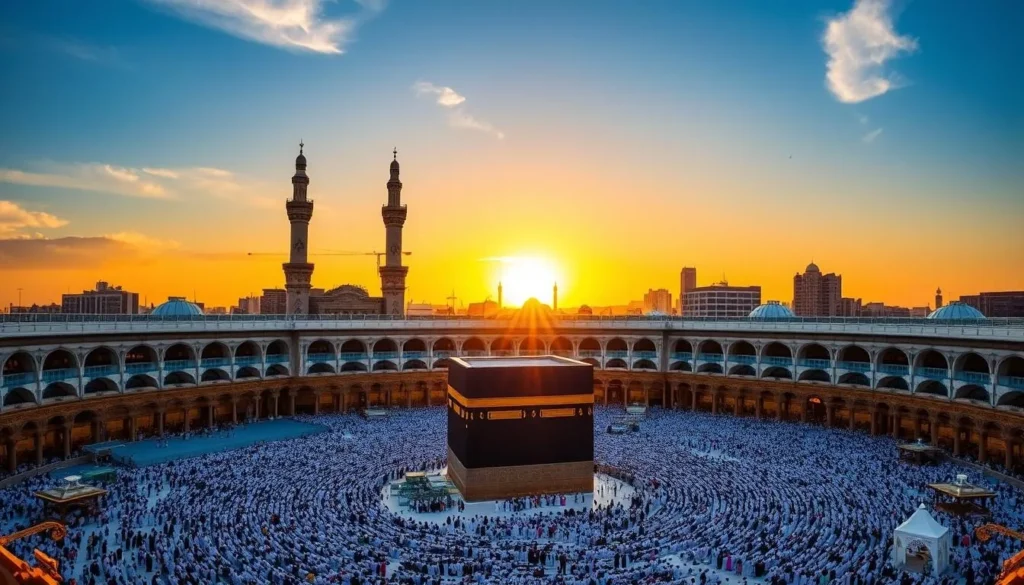
Mecca’s Masjid al-Haram is a place of profound reverence, embodying the essence of Islamic faith and practice. As the largest mosque in the world, it surrounds the holy Kaaba, making it the most sacred site in Islam. For Muslims, this place is not only the direction of prayer but also the center of the Hajj and Umrah pilgrimages.
The Masjid al-Haram has undergone significant expansions throughout its history to accommodate the growing number of pilgrims. Despite these changes, it remains a symbol of the strong faith of Muslims worldwide. At its heart is the Kaaba, a cube-shaped structure draped in black cloth with gold calligraphy, known as the Kiswah.
The Sacred Kaaba
The Kaaba is considered the significance of Islamic worship, serving as the direction Muslims face during prayer. It’s believed to have been built by Prophet Ibrahim (Abraham) and his son Ismail (Ishmael). The Kaaba’s simple, cube-shaped design belies its profound importance in Islam.
For pilgrims performing Hajj or Umrah, the Kaaba is the focal point of their pilgrimage. The ritual of circumambulating the Kaaba, known as Tawaf, is a deeply spiritual experience that connects Muslims with their religious heritage.
The Black Stone (Hajar al-Aswad)
Embedded in the eastern corner of the Kaaba is the Black Stone, or Hajar al-Aswad. According to Islamic tradition, this stone was given to Prophet Ibrahim by the Angel Gabriel. Pilgrims strive to touch or kiss the Black Stone during Tawaf, as it is believed to be a sacred act that cleanses sins.
The Black Stone is seen as a symbol of the covenant between God and Prophet Ibrahim. Its significance is deeply rooted in Islamic history and is a powerful reminder of the prophet muhammad‘s teachings.
Performing Tawaf Around the Kaaba
Tawaf is one of the most important rituals performed in the Masjid al-Haram. Pilgrims walk seven times counterclockwise around the Kaaba, symbolizing their unity with other Muslims and their devotion to their faith. This ritual is a deeply moving experience that embodies the spiritual significance of the masjid al-haram.
During Tawaf, pilgrims also attempt to touch or kiss the Black Stone, reaffirming their connection to the Islamic heritage and the prophet muhammad‘s teachings. The act of Tawaf is a powerful expression of faith and unity among Muslims.
Exploring the Zamzam Well
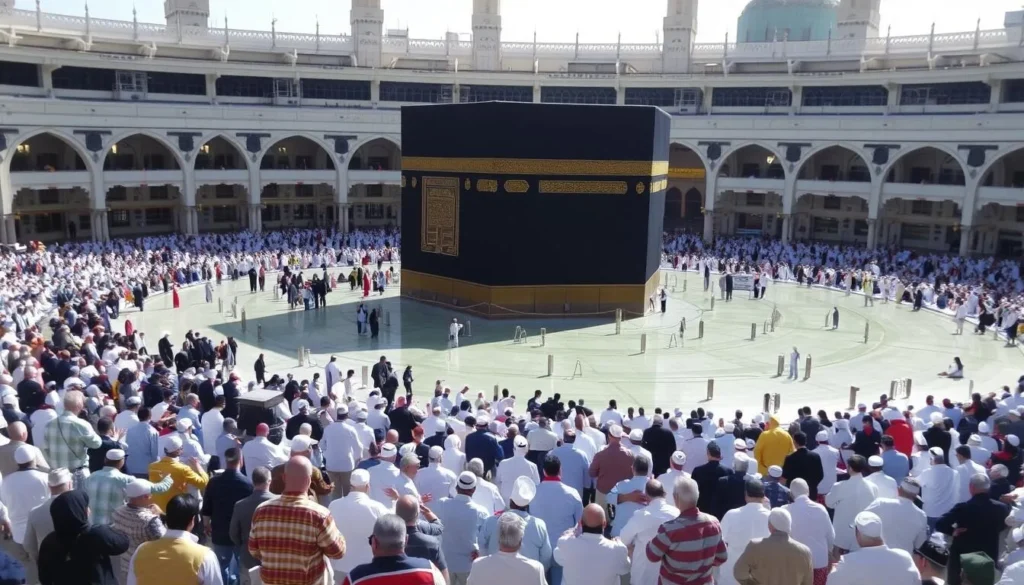
In the midst of the bustling Masjid al-Haram lies the revered Zamzam Well, a symbol of faith and spirituality for Muslims globally. This sacred site is intricately linked to the history of Prophet Ismail and his mother, Hajar, whose desperate search for water in the desert led to the miraculous discovery of the Zamzam spring.
Historical Background and Significance
The Zamzam Well has been a source of life and strength for pilgrims for centuries. According to Islamic tradition, Hajar, the wife of Prophet Ibrahim, found the well while searching for water for her infant son, Ismail. This historical event is seen as a divine miracle, and the well has since become a crucial part of Islamic pilgrimage. The water from the Zamzam Well is believed to have healing properties and is considered blessed, nourishing both the body and soul.
The significance of the Zamzam Well extends beyond its historical importance; it is a spiritual cornerstone for Muslims worldwide. The well’s connection to Prophet Ibrahim’s family and its role in sustaining pilgrims over thousands of years underscore its religious significance.
Drinking the Sacred Water
Drinking from the Zamzam Well is a cherished ritual for pilgrims, who often describe the water as having a distinctive and refreshing taste. The experience of drinking from the well is deeply personal and spiritual, with many pilgrims believing that the water possesses healing properties. As you drink the sacred water, you’re participating in a tradition that has been passed down through generations of Muslims.
The act of drinking Zamzam water is not just about quenching thirst; it’s about connecting with a rich history and a community of believers. Pilgrims often take the water home as a precious gift for family and friends, symbolizing the blessings and memories of their pilgrimage.
Modern Facilities and Access
The Zamzam Well is now housed in a modern complex, making it easily accessible to the millions of pilgrims who visit Mecca each year. The facilities have evolved to accommodate the large number of visitors while preserving the religious significance of the site. As a result, pilgrims can easily drink from the well and take some of the sacred water home.
Regulations regarding the transport of Zamzam water are in place to ensure its safe handling and distribution. Despite these regulations, the tradition of taking Zamzam water home remains an important part of the pilgrimage experience, allowing pilgrims to share the blessings with others.
Mecca, Saudi Arabia: Best Things to Do – Top Picks
Mecca, the holiest city in Islam, offers a plethora of spiritual experiences that attract pilgrims and visitors from around the world. As you plan your visit to this sacred place, you’ll discover a range of activities that will enrich your spiritual journey.
Performing Umrah: A Mini-Pilgrimage
Performing Umrah is one of the most significant experiences you can have in Mecca. This “mini-pilgrimage” can be undertaken at any time of the year, unlike Hajj, which has specific dates. Umrah involves several rituals, including Ihram, Tawaf, Sa’i, and Halq or Taqsir. Ihram is a state of spiritual purity where you wear special garments and refrain from certain activities. Tawaf involves circumambulating the Kaaba seven times, while Sa’i requires you to walk between two hills, Safa and Marwa, seven times. Finally, you’ll undergo Halq or Taqsir, which involves cutting your hair as a symbol of spiritual renewal.
Umrah is a powerful spiritual experience that allows you to connect with the history and traditions of Islam. By performing these rituals, you’ll be following in the footsteps of Prophet Muhammad and his companions, creating a deep sense of connection and devotion.
| Ritual | Description |
|---|---|
| Ihram | A state of spiritual purity marked by special garments and certain prohibitions. |
| Tawaf | Circumambulating the Kaaba seven times. |
| Sa’i | Walking between the hills of Safa and Marwa seven times. |
| Halq or Taqsir | Cutting your hair as a symbol of spiritual renewal. |
Praying in the Masjid al-Haram
Praying in the Masjid al-Haram is a profoundly spiritual experience. The mosque is considered one of the most sacred places on Earth, and each prayer performed here is believed to be equivalent to 100,000 prayers performed elsewhere. The Masjid al-Haram is home to the Kaaba, the Black Stone (Hajar al-Aswad), and the Zamzam Well, making it a focal point for pilgrims and visitors.
As you pray in the Masjid al-Haram, you’ll be surrounded by thousands of other worshippers, creating a powerful sense of community and shared devotion. The mosque’s vast expanse can accommodate over two million worshippers, making it one of the largest and most impressive religious sites in the world.
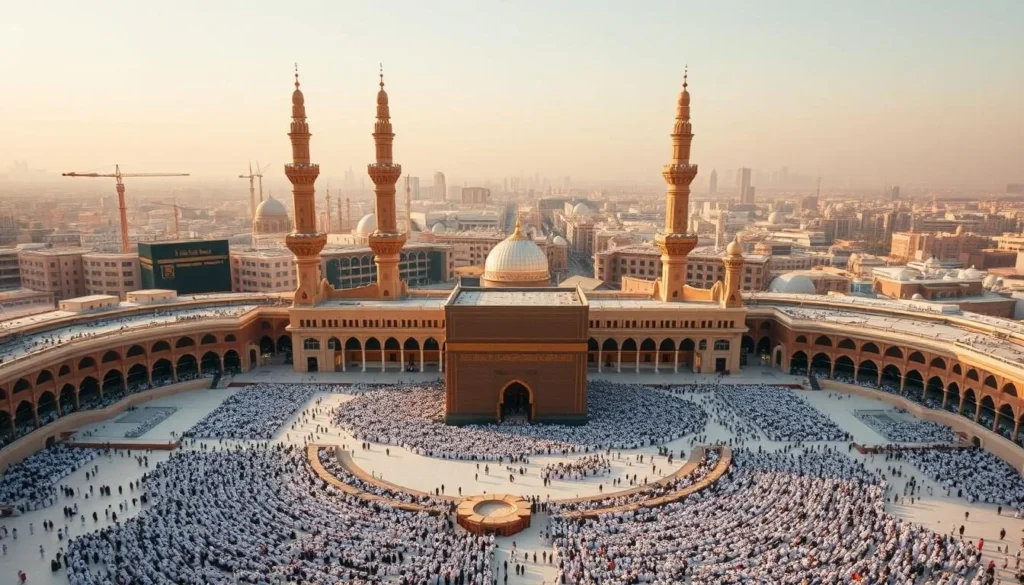
Exploring the Expansion of the Grand Mosque
The Grand Mosque, or Masjid al-Haram, has undergone significant expansions over the years to accommodate the growing number of pilgrims. These expansions have included the addition of new wings, courtyards, and facilities to enhance the pilgrim experience. The mosque now features advanced cooling systems, escalators, and modern amenities to ensure that worshippers can perform their rituals comfortably.
The expansion projects have not only increased the mosque’s capacity but have also preserved its historical and spiritual significance. As you explore the mosque, you’ll notice the blend of traditional and modern architecture, creating a unique and awe-inspiring environment.
Sacred Mountains of Mecca
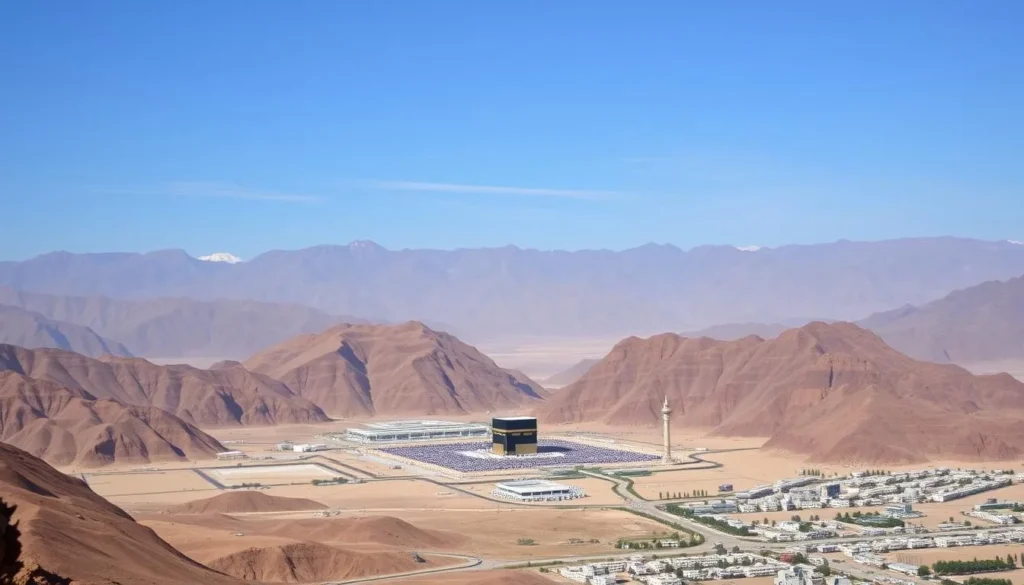
As you explore the spiritual landscape of Mecca, you’ll discover the sacred mountains that have been pivotal in Islamic history. These mountains are not just geographical features; they are imbued with deep religious significance and historical importance.
Jabal al-Nour and the Cave of Hira
Jabal al-Nour, or ‘The Mountain of Light,’ is renowned for housing the Hira cave where Prophet Muhammad received his first revelation from Angel Gabriel, marking the beginning of Islam. The hike to the cave provides a moderate physical challenge and a profound spiritual experience for reflective pilgrims.
The Cave of Hira is a significant historical religious site where Muslims can connect with the pivotal moment in Islamic history. As you climb the mountain, you’ll experience a sense of tranquility and spiritual connection.
Jabal Thawr and Its Historical Significance
Jabal Thawr is another significant mountain in Islamic history, home to the cave where Prophet Muhammad and Abu Bakr sought refuge from their persecutors during the migration to Medina. The mountain offers a strenuous hike for pilgrims and visitors, testing their physical endurance.
The cave in Jabal Thawr is a testament to the trials faced by the early Muslims and the historical significance of this period in Islamic history.
Mount Arafat: The Mountain of Mercy
Image of Mount Arafat
Mount Arafat, or “Jabal al-Arafat,” is a sacred and historically significant site located on the plain of Arafat, just outside Makkah, Saudi Arabia. It plays a central role in the annual Islamic pilgrimage of Hajj and holds great spiritual significance in Islam.
During Hajj, pilgrims gather on the plain of Arafat, seeking forgiveness and spiritual rejuvenation. The significance of this mountain is deeply rooted in Islamic history and faith.
The Abraj Al Bait Towers and Clock Tower Museum
The Abraj Al-Bait Towers is a government-owned mega project located in Mecca, Saudi Arabia. It is a complex of seven skyscrapers, with the central clock tower being one of the tallest in the world.
The Complex
The towers are not just an architectural marvel but also a significant cultural and religious landmark. The complex includes a hotel, residential apartments, and a large shopping mall.
The World’s Tallest Clock Tower
The clock tower is a marvel of engineering, visible from afar. It stands as a symbol of modernity and tradition blended together.
Shopping and Dining
Visitors can enjoy a variety of shopping and dining experiences. The complex offers several high-end brands and local boutiques.
Exploring Mina: The City of Tents
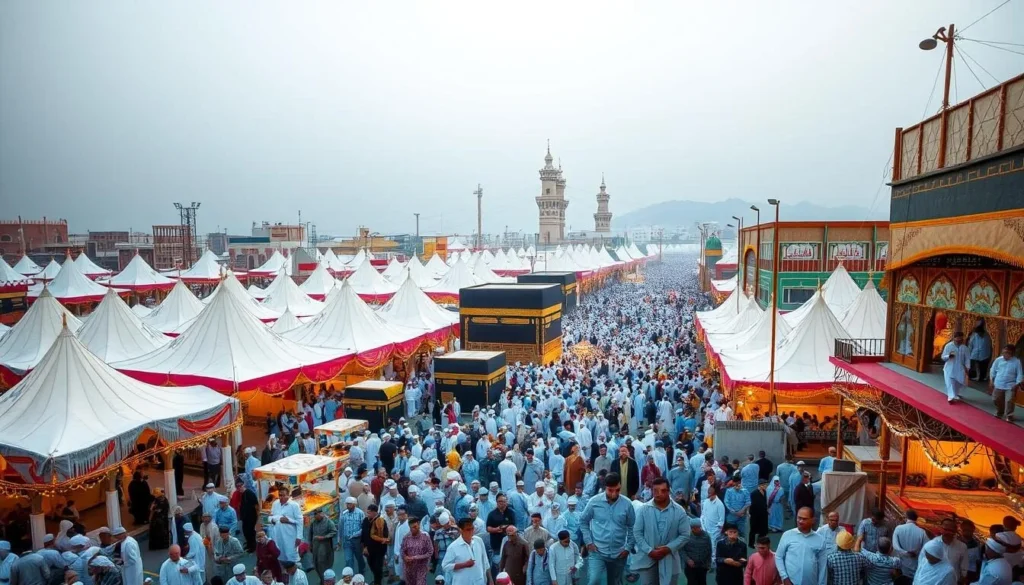
During Hajj, Mina transforms into a vast tent city, accommodating millions of pilgrims. This transformation is not just about the physical change but also signifies the spiritual journey that pilgrims undertake.
Significance During Hajj
Mina is a special place for Muslims, known for its crucial role in the Hajj pilgrimage. The Ministry of Hajj and Umrah provides modern tents for pilgrims to stay in for three days. It’s here that pilgrims perform the ritual of stoning the devil at the Jamarat, symbolizing the rejection of Satan’s temptations.
The area is also significant for the ritual of animal sacrifice, making Mina very important during the Hajj pilgrimage. This site is steeped in religious significance, and understanding its importance can enhance a pilgrim’s experience.
The Jamarat Bridge and Stoning Ritual
The Jamarat Bridge is a multi-level structure where pilgrims perform the symbolic stoning of the devil, representing their rejection of evil and temptation. This ritual is rooted in the story of Prophet Ibrahim and his resistance to Satan’s attempts to dissuade him from fulfilling God’s command.
Pilgrims stone the three pillars that represent Satan, an act that is deeply symbolic and significant in the Hajj rituals. The Jamarat Bridge has been expanded over the years to accommodate the increasing number of pilgrims, ensuring that all can perform this crucial ritual safely.
Modern Facilities in Mina
The Saudi government has developed modern facilities in Mina, including air-conditioned tents, medical services, and infrastructure to accommodate the massive influx of pilgrims. These facilities are crucial in ensuring the comfort and safety of the millions who gather here during Hajj.
From Mina, pilgrims can easily access other important sites in Mecca, making it a central hub during the Hajj season. The city of tents is a marvel of modern logistics and planning, showcasing Saudi Arabia’s capability to host such a massive event.
Historical Sites and Museums in Mecca
Mecca, a city steeped in history and spirituality, is home to numerous significant historical sites and museums that showcase its importance in the Islamic world. Visitors to Mecca can explore these sites to gain a deeper understanding of the city’s rich cultural heritage.
Makkah Museum
The Makkah Museum houses a fascinating collection of artifacts, manuscripts, and exhibits that chronicle the history of Islam and the city of Mecca. With a vast array of relics on display, visitors can gain a deeper understanding of the city’s significance in the Islamic world.
Masjid al-Jin
Masjid al-Jin is a significant historical site in Mecca, known for being the location where the Prophet Muhammad recited the Quran to a group of jinn. The mosque is an example of Islamic architecture and a must-visit destination for anyone interested in learning about the history of Mecca.
Jannat al-Mu’alla Cemetery
Jannat al-Mu’alla Cemetery is a historic burial ground where many of the Prophet Muhammad’s family members and companions are buried. Visitors can pay their respects and gain a deeper understanding of the city’s rich cultural heritage.
Image of Jannat al-Mu’alla Cemetery
Shopping and Souvenirs in Mecca
As you journey through Mecca, you’ll discover a variety of shopping options that cater to pilgrims and visitors alike. The city offers a unique blend of traditional and modern shopping experiences, making it a fascinating place to explore.
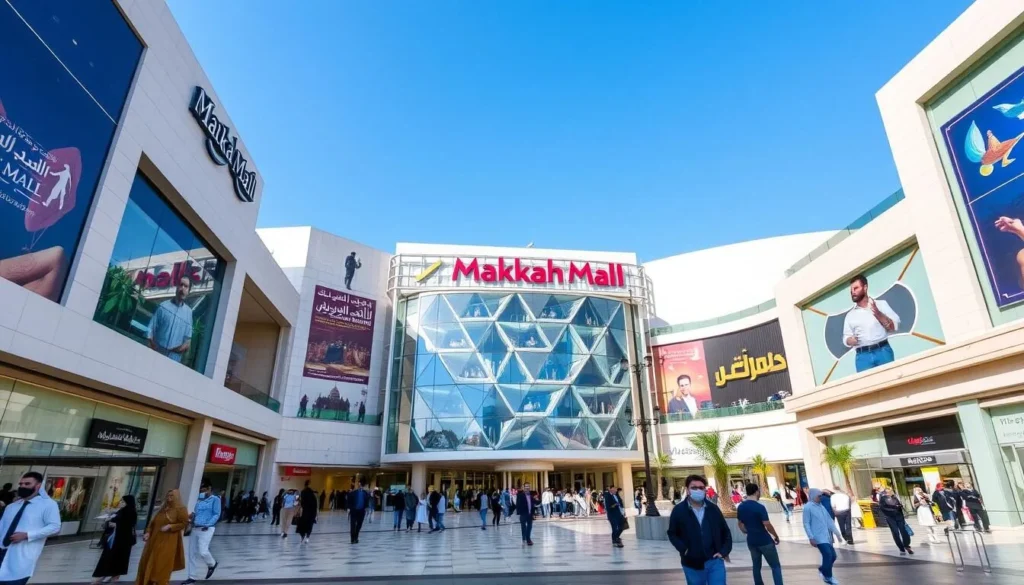
Makkah Mall and Modern Shopping Centers
Makkah Mall, located on King Abdullah Road, is a top shopping destination in Mecca. It features a wide range of local and international brands, making it a favorite among visitors. The Abraj Al Bait Towers is another key place in Makkah, offering modern comforts and a variety of shopping options.
The Makkah Mall takes about 1.5 hours to fully explore, providing a great shopping experience. You can find everything from local handicrafts to international brands, catering to the diverse needs of pilgrims and tourists.
Traditional Markets and Souks
Mecca is also home to traditional markets and souks that have served pilgrims for generations. These markets offer authentic Arabian goods, including handcrafted prayer rugs, locally produced perfumes, and spices. Visiting these souks is a great way to experience the local culture and find unique souvenirs.
Best Religious Souvenirs to Bring Home
When shopping in Mecca, you’ll find a variety of religious souvenirs that make meaningful keepsakes. Some popular items include prayer beads (tasbih), Zamzam water containers, and beautifully crafted Qurans. These souvenirs not only serve as reminders of your spiritual journey but also connect you to the religious experience of visiting the holy city.
Understanding the cultural significance behind these traditional items can enhance your shopping experience. You’re not just buying souvenirs; you’re taking home a piece of the spiritual journey that you can cherish forever.
Culinary Experiences in the Holy City

As you step into Mecca, the aroma of exotic spices and traditional Saudi cuisine envelops you, offering a culinary journey like no other. The holy city is a melting pot of cultures, and its food scene reflects this diversity.
Traditional Saudi Arabian Cuisine
Traditional Saudi Arabian cuisine is rich and flavorful, with dishes that have been passed down through generations. You should try kabsa, the national dish made with spiced rice and meat, often served at special occasions. Another popular dish is mandi, a traditional meal from the Hadhramaut region, known for its flavorful meat and rice. Don’t miss out on mutabbaq, a stuffed pancake that is a favorite among locals and visitors alike.
These dishes are not only delicious but also give you a glimpse into the culinary heritage of Saudi Arabia. The use of aromatic spices, herbs, and the emphasis on hospitality are key elements that make Saudi cuisine unique.
International Dining Options
Mecca is not just about traditional Saudi cuisine; it also offers a wide range of international dining options. You can find restaurants serving everything from Middle Eastern to Asian and Western cuisine, catering to the diverse tastes of pilgrims and visitors from around the world.
Whether you’re in the mood for something familiar or want to try something new, you’ll find that Mecca’s restaurants offer a variety of halal options, ensuring that everyone can enjoy a meal.
Where to Find the Best Meals in Mecca
From street food stalls near the Masjid al-Haram to high-end restaurants in luxury hotels, Mecca offers a variety of dining experiences. For a truly local experience, try eating at the local eateries and food courts, where you can enjoy traditional dishes in a lively atmosphere.
During Ramadan, the city comes alive with special iftar meals, offering a unique culinary experience. You can also explore the local markets and souks for a wide range of Middle Eastern sweets and delicacies.
Accommodation Options in Mecca
When visiting Mecca, finding the right accommodation is crucial for a comfortable experience. Mecca offers a range of hotels and lodging options to suit various budgets and preferences.
Luxury Hotels Near the Grand Mosque
For those seeking luxury, Mecca offers high-end hotels with stunning views. The Fairmont Makkah Clock Royal Tower and the Hilton Makkah Convention Hotel are iconic properties that offer unparalleled luxury and comfort.
Mid-Range Accommodation Options
For travelers on a budget, mid-range hotels are available. These hotels are often within walking distance of the Grand Mosque.
Budget-Friendly Options
For those on a tight budget, there are affordable accommodation options. Many of these budget-friendly hotels and hostels offer basic amenities.
Practical Tips for Visiting Mecca
Visiting Mecca is a significant experience for Muslims worldwide. To make the most of your trip, it’s essential to be aware of the practical aspects that will make your journey comfortable and spiritually fulfilling.
Dress Code and Etiquette
Dressing modestly is a must. Men are required to wear simple white garments. Women should cover their bodies and hair.
Understanding and respecting local customs is also crucial.
Transportation Within the City
Mecca has a well-organized transportation system. Shuttle services and taxis are readily available.
Health and Safety Considerations
Stay hydrated and be aware of your surroundings to ensure a safe and healthy trip.
Beyond Mecca: Day Trips and Nearby Attractions
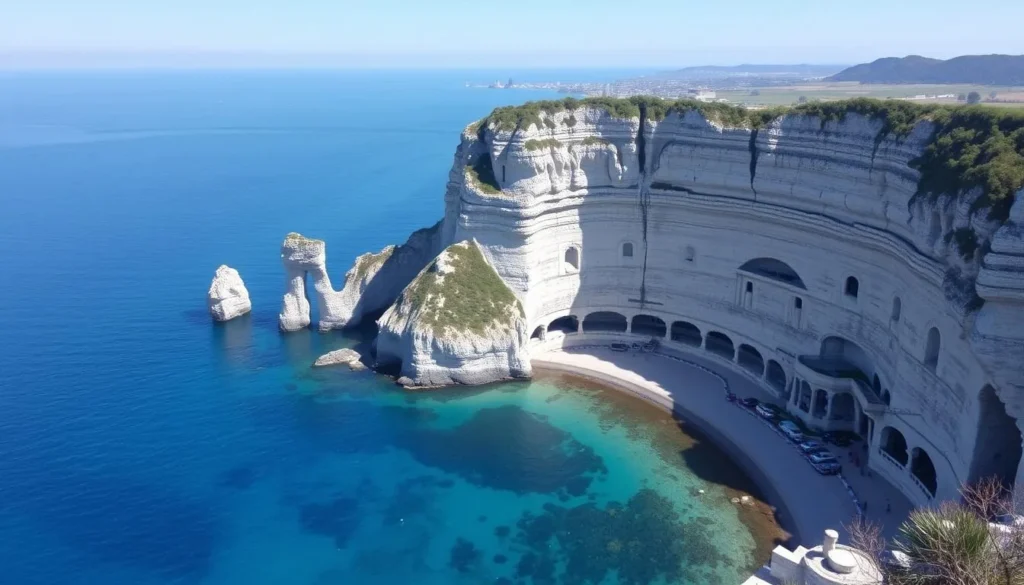
Mecca serves as a gateway to various day trips and nearby attractions that showcase the region’s unique blend of history, culture, and natural beauty. As you explore beyond the sacred city, you’ll discover enriching experiences that complement your visit to Mecca.
Visiting Medina: The Prophet’s City
Medina, the second holiest city in Islam, is a serene spiritual destination and the final resting place of Prophet Muhammad. Your visit to Medina will include key sites such as the Prophet’s Mosque (Masjid an-Nabawi), the historic Quba Mosque, and the battlefield of Uhud, each holding profound significance in Islamic history.
These historical sites offer a glimpse into the life and times of Prophet Muhammad and the early days of Islam, providing a meaningful experience for visitors.
Taif: The City of Roses
Known as the “City of Roses,” Taif is a refreshing destination with its pleasant climate, beautiful gardens, and historical significance as a summer retreat for the people of Mecca. You’ll enjoy exploring this charming place and experiencing its natural beauty.
Jeddah’s Historical District
Jeddah, Saudi Arabia’s commercial hub, is home to the UNESCO World Heritage site of Al-Balad, known for its distinctive coral stone buildings and traditional architecture. A visit to this historic place will give you insight into the region’s rich cultural heritage and the history of this ancient city.
These day trips from Mecca not only enhance your understanding of the region’s history and culture but also provide a unique experience of the places and attractions that Saudi Arabia has to offer.
The Spiritual Impact of Visiting Mecca
Mecca is more than a religious site; it’s a place where millions of Muslims connect with their faith on a deeper level. The experience of visiting Mecca is often described as a life-changing journey that transforms one’s relationship with their faith.
![]()
Personal Transformations and Experiences
Visiting Mecca has a profound impact on pilgrims, often leading to personal transformations and spiritual awakening. Many visitors describe their experience as a renewal of their faith, where the pressures of worldly life fade against the backdrop of divine connection.
- The emotional journey begins with the first sight of the Kaaba, a moment that is often overwhelming.
- The shared rituals and prayers create a sense of unity and brotherhood among Muslims from diverse backgrounds.
- The simple white garments worn by pilgrims reinforce Islam’s emphasis on equality before God.
These experiences lead to a deeper sense of purpose and often result in a renewed commitment to faith after returning home.
Connecting with the Global Muslim Community
The spiritual journey to Mecca connects contemporary Muslims with the historical traditions of their faith and with the global community of believers. Being among millions of fellow Muslims fosters a sense of belonging to a larger community.
- The rituals performed in Mecca create a shared experience that transcends cultural and linguistic differences.
- Pilgrims report a lasting impact after returning home, including changed priorities and a deeper sense of purpose.
This connection with the global Muslim community is a significant aspect of the Mecca experience, making it a truly unique place of spiritual significance.
Conclusion
As you conclude your journey through the sacred city of Mecca, Saudi Arabia, you are left with a profound sense of awe and reverence for this holy place. The experience of visiting Mecca is truly life-changing, offering a unique blend of spiritual significance and cultural richness that attracts millions of pilgrims from around the world.
The city, with its majestic Masjid al-Haram and the awe-inspiring Kaaba, stands as the heartland of Islamic faith, drawing visitors to perform the Hajj or Umrah pilgrimage. As you explore the historical Zamzam Well and other sites of religious and cultural significance, you become immersed in the profound spiritual atmosphere and rich traditions that define this sacred destination.
Mecca has evolved to meet the needs of modern-day visitors, offering a blend of historical charm and contemporary amenities. You can explore ancient architecture and landmarks, or enjoy vibrant shopping and dining experiences that showcase the city’s hospitality. Whether you’re on a Makkah pilgrimage, seeking an Islamic tourism experience, or looking for a spiritual journey, Mecca will leave an indelible mark on your heart and soul.
The significance of Mecca extends beyond its religious importance, as it has become a symbol of unity and spiritual growth for Muslims worldwide. The city’s ability to balance its ancient heritage with modern developments is a testament to its enduring appeal, accommodating millions of visitors each year.
As you’ve discovered through this journey, Mecca offers a wide range of experiences, from performing religious rituals at the Masjid al-Haram to exploring the city’s sacred mountains and historical sites. The practical aspects of visiting Mecca, including accommodation options, dining experiences, and cultural considerations, have been carefully planned to ensure a smooth and meaningful journey.
The transformative impact of visiting Mecca is profound, often described as a life-changing experience that deepens one’s faith and spiritual connection. As you reflect on your journey, you come to understand the significance of this holy city and its role in the lives of millions of Muslims around the world.
In conclusion, Mecca, Saudi Arabia, stands as a unique destination that offers a rich tapestry of spiritual, cultural, and historical experiences. As you carry the memories of your journey with you, you are reminded of the city’s enduring significance and its place in the hearts of pilgrims worldwide.
—
The above is subject to change.
Check back often to TRAVEL.COM for the latest travel tips and deals.
